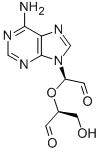Uses
Adenosine, periodate oxidized has been used:
- as a methylarginine transferase inhibitor in the human embryonic kidney (HEK)-293 T cells
- as a methylase inhibitor in H4 neuroglioma
- as a broad inhibitor of S-adenosylmethionine (AdoMet)-dependent methyltransferases in mouse embryo fibroblast NIH3T3 cells
Uses
2-(1-(6-aMino-9H-purin-9-yl)-2-oxoethoxy)-3-hydroxypropanal is an inhibitor of S-adenosylhomocysteine hydrolase (AdoHcy hydrolase ) and it may be used in studies on the role of AdoHcy hydrolase in adenosine induce apoptosis and related S-adenosylhomocysteine-regulated processes. Adox is a methylation inhibitor that inhibits histone methytransferases (HMTase) and arginine methylation.
Biological Activity
adenosine dialdehyde (adox) has been identified as an indirect methyltransferase inhibitor.histone methyltransferases are a group of enzymes that catalyze the methylation of histone lysine and arginine by adding methyl groups to specific histone arginine or lysine residues.
Biochem/physiol Actions
Adenosine, periodate oxidized (Adox) is a protein arginine methyltransferases (PRMTs) inhibitor. It also inhibits the enzyme S-adenosylhomocysteine hydrolase and induces apoptosis. Its inhibitory effect on histone methyltransferases prevents histone methylation. Adox also elicits intrinsic cytotoxic properties.
in vitro
previous cell-based study showed that the treatment of cells with the methyltransferase inhibitor adenosine dialdehyde (adox) could lead to cell cycle arrest and death in different tested cell types. in addition, the e form of cell death and phenotypical outcom was found to be strikingly dependent on the concentration of adox. results showed that lower adox concentrations could result in a g2 arrest and predominantly cause apoptosis, which was measured by biochemical and morphological criteria. in contrast, higher concentrations of adox led to a novel and so far undescribed form of cell death that was characterized by distinct, caspase-independent alterations of the cell shape with a marked protuberation of the nucleus, actin aggregation, cytoplasmic extensions, as well as incomplete chromatin condensation [1].
References
[1] schwerk c, schulze-osthoff k. methyltransferase inhibition induces p53-dependent apoptosis and a novel form of cell death. oncogene.2005 oct 27;24(47):7002-11.


